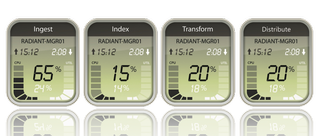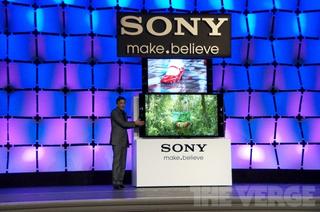For once-dominant vendors at the NAB Show, it’s now adapt or die
At the NAB Show in Las Vegas, it was clear that rapidly changing viewer consumption habits and the myriad of technical challenges broadcasters are facing to serve them has caused major broadcast equipment suppliers to modestly submit to the penetration of lower-cost competitors and rethink their products offerings. Indeed, for companies like Avid, Chyron, Grass Valley, Harris, Panasonic, Quantel, Snell and Sony, the challenge is clearly one of getting more in tune with what’s going on in the market and dramatically adjusting to the changing times.
Make no mistake, smaller-sized companies (in terms of revenue) are equally challenged to “find the next big thing,” but it’s a bit easier for them to change course quickly. And most are, as evidenced by the proliferation on the exhibit show floor of cloud-based components, Web-based interfaces and file management software that cost-effectively add new capabilities.
In some cases companies (e.g., Chyron, Grass Valley and Harris Broadcast) have literally sold their business to stay afloat. In speaking with key company executives at The NAB Show, they say it’s all about company preservation in a changing broadcast equipment-buying environment.
The various strategic moves are sorely needed. The IABM (International Association of Broadcasting Manufacturers) released results of its latest End User Report, Industry Index, and Benchmark Report, which finds that over the past year, while the growth in overall sales in the market for broadcast and media technology products and services has steadily improved to 4.7 percent over last year, profits are still falling in real terms and are down 12.7 percent year on year.
Uncertainty abounds
“So much is happening in the industry right now, and it’s happening so fast,” said Patrick Harshman, CEO of Harmonic. His company, once a major player in cable headend technology, has retooled and expanded through a series of acquisitions and a shedding of less profitable product lines. “There’s a lot of uncertainty and concern among customers, and we as a company, and as an industry have to address those concerns. We also see a lot of instability among other vendors in this space, so we have to carefully consider all of our options and adjust accordingly so that our business remains stable.”
Among the hard choices manufactures are making include significant staff reductions, reduced marketing and R&D spending, and refreshing our product lines that have languished for the past three years — as the economy struggled and stations held off of major purchasing decisions. The industry’s slow move to multiplatform (TV, Internet and mobile) delivery of content resulted in renewed interest in spending at the NAB Show among TV stations, networks and multichannel operators considering new purchases necessary to build out such infrastructures.
Refreshing product lines to improve market share
At The NAB Show, Snell launched its new “Snell On Demand” framework, that marks the beginning of a company-wide migration of its image-processing tools from dedicated hardware platforms to software-based applications that can be elastically provisioned in file, cloud-based and virtualized infrastructures.
This makes the previously expensive technology accessible to more customers in a faster, “by the drink” fashion, and should help Snell improve its bottom line. It’s clearly a necessary evolution for a company with a history of offering proprietary, hardware-based solutions.
“With Snell On Demand, Snell is putting the cost/benefit equation fairly and squarely into the hands of the customer,” said Simon Derry, CEO at Snell. “It's very simple — customers can choose to buy as much or as little processing resource as fits their business model.”
Avid announced significant reductions in the price of its Media Composer (now in version 7) and other software products as a way to regain market share lost to newer competitors with lower price (and equally capable) offerings. The latest version of its popular ProTools audio editing software is now available for $699, and it’s got more lots more features than the previous version.
“Avid has to change, as many of our competitors in this industry have to do, “ said newly appointed president Louis Hernandez, adding that the industry is just now realizing that it’s no longer business as usual. Customer requirements have changed, and so must we as an equipment supplier. I want Avid to be more than a footnote in history; we want to lead the change.”

Quantel has gone from a company that offered proprietary hardware solutions that were considered too costly for many, to a software-based company that is now leveraging an “Internet of Frames” strategy and the remote (“cloud”) storage, where every frame gets a unique ID and can be retrieved and manipulated very quickly. Using this new IT-friendly strategy, users might not need to invest in an archive on premises and can leverage the lower cost of off-the-shelf workstations running Quantel software.
“Our product development is no longer only about our vision of the future, it’s more importantly our customers’ vision as well, and what they want from us” said Ray Cross, president of Quantel. “We [are] addressing the perception of Quantel technology as being too expensive and want to be affordable for everyone. Our Broadcast business pays the bills for other development, so we have to preserve it as best we can.”
Stemming the tide
At Wohler, a veteran maker of audio monitoring hardware (and more recently software) used across the industry, a recent acquisition of Radiant Grid, a developer of file-based signal processing solutions, has helped it gain new business it would not have attracted otherwise.

“We’re spending a lot of money of growing the company and supporting a whole new category of products, and it makes me nervous sometimes,” said Carl Dempsey, president of Wohler, “but we feel it’s absolutely necessary to move us into the future. Our company has 26 years of audio monitoring experience, and the market for 1RU boxes with speakers is not going away completely, but it’s shrinking, and we have to be ready for the change in customer attitudes or we risk becoming obsolete.”
Like Panasonic, Sony, once one of the preeminent suppliers of broadcast cameras, recording devices and other equipment, has undergone a series of layoffs and product line reductions to remain competitive. Both companies’ previously high-priced products are no longer the favorite of TV station news departments, so some newer models are now available at lower price points.
Although Alec Shapiro, Sony’s Broadcast division president, said during the company’s NAB press conference that “Our market share in Broadcast is as strong as its ever been,” HD cameras from companies like Canon and JVC continue to be the current leading sellers, due to their lower cost and smaller form factor.

At the NAB Show, Panasonic, perhaps to save money, did not even host a press conference — something it has done consistently for decades — and its exhibit was obviously less crowded with attendees than in previous years (some say due to a paucity of new products this year).
Sony did announce two new XDCAM cameras for the ENG market. However, the company is clearly focused on the higher-end operator looking to capture 4K (and higher?) images and most of the excitement was centered on 4K production. This strategy, it was announced, is a result of a directive from new president and CEO Kazuo Hirai, who wants Sony to “own” the market for UltraHD quality production. Another hint of its end-to-end vision, Sony showed two new 4K televisions that would go on sale in the fall — including a 55in. model for less than $6000.
Selling out to start anew
Harris, which was recently acquire by venture capitalist The Gores Group, unveiled a new logo (although that will change in a year or so) and a stripped-down product line that plays to its core strength of reliable master control, channel-in-a box playout, routing, and automation technology. RF television transmitters were also on display, mainly targeted at emerging international markets.
Before the start of the NAB exhibits, Harris Broadcast president Harris Morris said, in referring to the company’s 91-year history, “We’re going to be the newest ‘old’ company on the show floor this year. We want to regain momentum for our technology by figuring out what products and services customers want most and delivering those as quickly as possible. That's how we’ll be successful. As a separate company now, we feel confident we can do that ”
Indeed, a member of The Gores Group team echoed that sentiment, while explaining that while his company’s investment is for the long haul “we’re not shy about saying we want to make a profit.
“The challenge of this industry is that the world is consolidating, and this has placed significant challenges on [Harris’] customers,” he said. “The faster we can deploy new technology, the more successful we’ll be.
One of Harris' success is its filed-based trafficking and billing platforms, called OSI, which is now deployed at 75 TV stations in the U.S., with 50 more waiting to come online this year. It’s a product category Harris typically would not have offered five years ago.

For its part, Grass Valley, perhaps most significantly of all, has refreshed its now trademark cameras with a new line, called the LDX series, that allows a user to purchase software “e-licenses” that can be accessed over the Internet to add new features and functionality via a simple download. Mobile production companies and rental houses are two initially targeted applications.
Newly appointed president Tim Thorsteinson, who actually ran the company many years earlier, before moving on to other vendors, has now returned to streamline the business. This has meant staff reductions and product-line adjustments that are now focused squarely on the live production market — where Grass Valley technology has been traditionally well accepted. Gone are the products that catered to the AV-staging market
“The industry is going through a lot of changes, and I’m here to return the company to profitability,” he said. “We need to be more agile and prepared for the future. I love this business, and Grass Valley is at the heart of it. I think the company is in better shape than the last time I ran the business, but we have work to do to get our profit margins up and be in line with other vendors that are currently more profitable than ours.”
Thorsteinson then cryptically related his experience with operating a business under a Venture Capital firm (in this case Francisco Partners) and the added pressure it brings to financially perform.
“In my experience with VCs, they usually give you five years to deliver the results they are after,” he said. “Grass Valley is now two years in with Francisco Partners, so we have to improve our margins in a hurry and make great products that people want to buy. I’m confident if we stay loyal to our customers we’ll be okay.”
Innovating to survive
Even smaller companies like Cobalt Digital, once a died-in-the wool maker of signal conversion “glue” products, has begun to offer filed-based transport stream signal monitoring (called “SpotCheck”) technology to stay relevant.
“We were a video-centric company that understands we have to migrate into new areas like audio and software to grow,” said Christopher Shaw, executive vice president of international sales and marketing for Cobalt. “What we’re doing now, more than ever, is looking beyond the horizon, maybe two years out, and trying to figure out where we need to go next. We understand that to survive we have to innovate.”
“The industry is clearly facing a lot of challenges, and it’s a tricky market right now,” Wohler’s Dempsey said, “but we think challenge makes people work harder, and we’re creating a lot of great new products in the face of this challenge in order to survive. Now, more than ever, it’s what you’ve got to do.”
Get the TV Tech Newsletter
The professional video industry's #1 source for news, trends and product and tech information. Sign up below.
